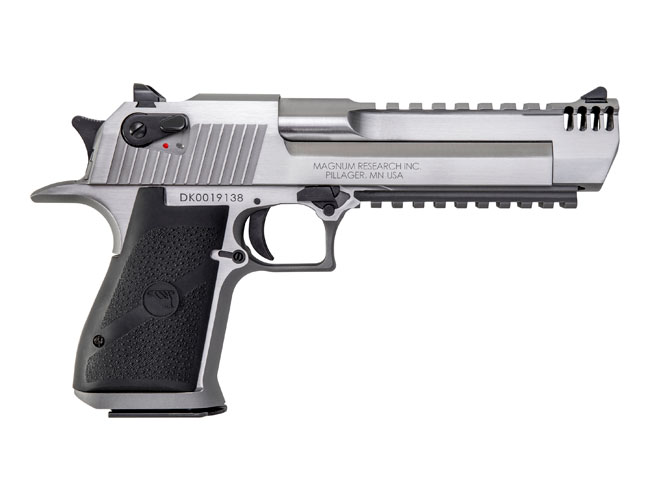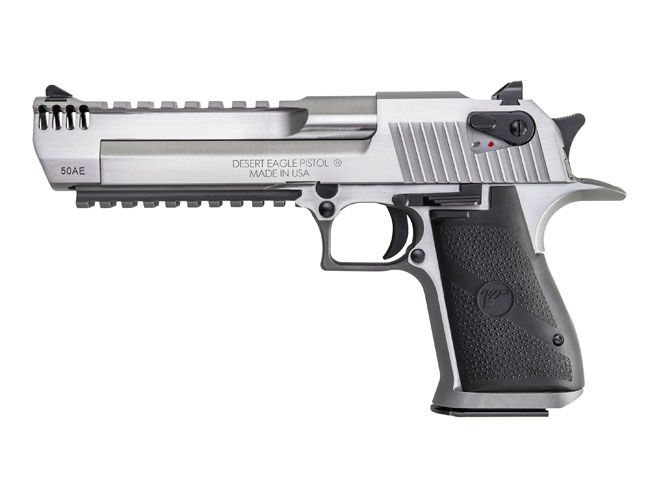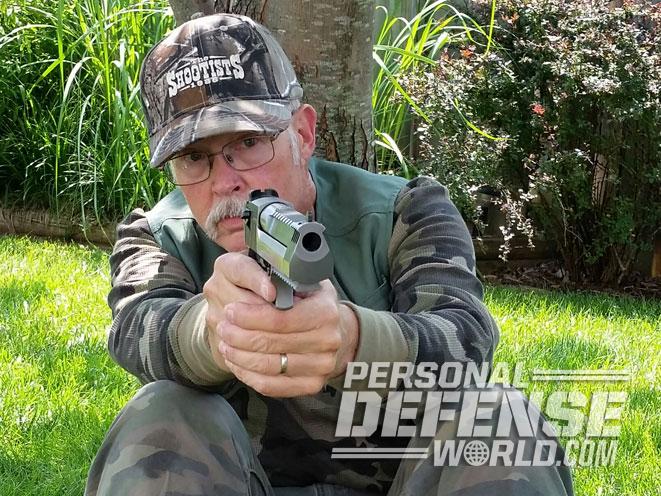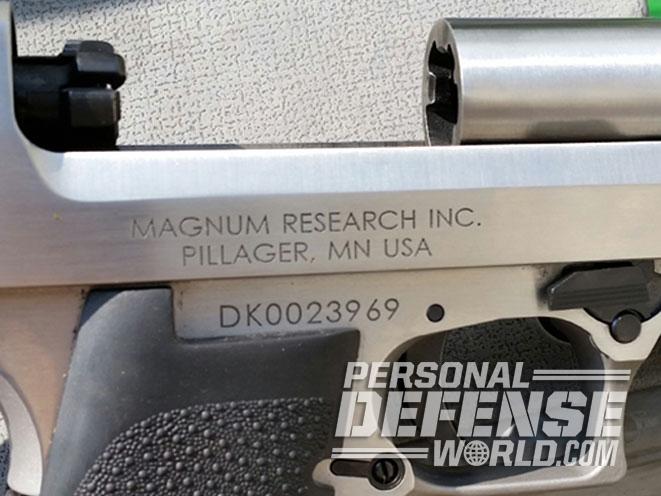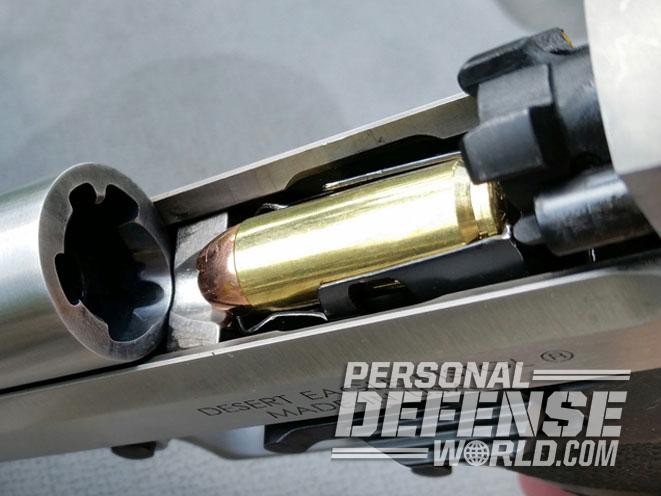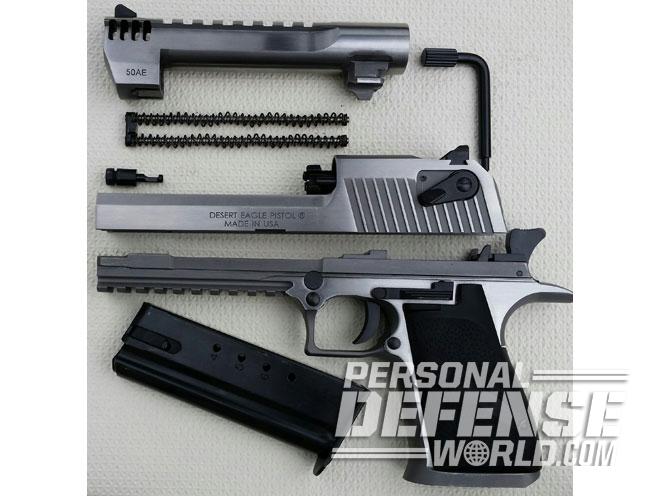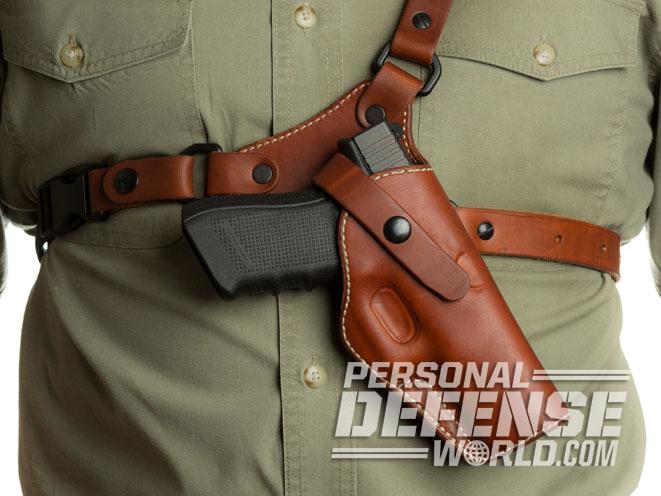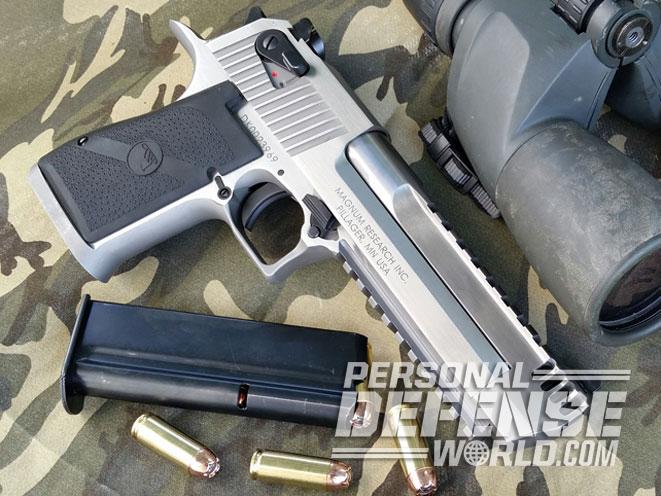Some 32 years ago, the Desert Eagle semi-automatic pistol was designed in the United States by Magnum Research, Inc. (MRI) and then taken to Israel and modified by Israeli Military Industries (IMI), where it was manufactured until 1995. Production of the Desert Eagle was then shifted to the U.S., where it was first made by Saco Defense in Maine. Then, in 2009, MRI began producing it in Pillager, Minnesota. Kahr Arms acquired MRI in mid-2010, and today the newest Desert Eagles are 100-percent made in the U.S.A.
First announced in late December 2014, MRI is now making the iconic Desert Eagle in stainless steel. This huge pistol, featured in over 500 movies and TV shows, is a favorite of Hollywood heroes and villains alike. For 2015, an even newer model of the Desert Eagle Mark XIX pistol was introduced, officially the DE50SRMB, which is crafted in stainless steel, chambered for the .50 AE cartridge and has an integral muzzle brake. It also has a Weaver-style top rail and a Picatinny bottom rail for all the usual accessories like lights, lasers or optics. The stainless steel finish is contrasted by several black parts, including the pebble-grain grips, fixed, combat-style sights, ambidextrous thumb safety, hammer, slide release, magazine catch, trigger and takedown latch. Overall, it’s an attractive handgun with strict attention paid to parts fit and finish.
Big Gun
Advertisement — Continue Reading Below
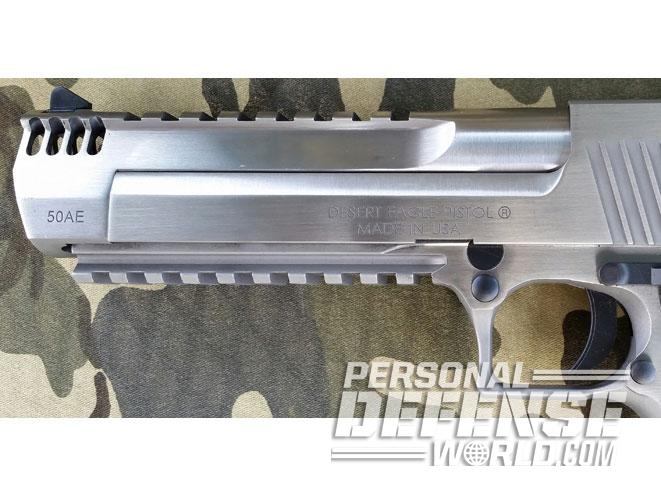
Of course, the most notable feature of the Desert Eagle is its size. With its 6-inch barrel, the gun has an overall length of 10.75 inches, a height of 6.25 inches, a width of 1.25 inches and an unloaded weight of 4.4 pounds.
RELATED STORY: MR9 Eagle – Magnum Research’s Covert 9mm Pistol
The next thing you’ll notice is this pistol’s action. It is not your typical blowback or locked-breech, short-recoil system. Instead, it more resembles what you might see on a centerfire rifle. The slide acts very much like a bolt carrier, and when it is fully retracted you’ll see what looks like an M16/M4-style bolt protruding from the rear. And, much like our military service rifle, the Desert Eagle is gas operated. When the pistol is fired, propellant gases travel through a small hole in the barrel breech into a tube under the barrel and then into a cylinder near the front of the barrel. A small piston at the front of the slide/bolt carrier is acted upon by the gases, pushing the slide rearward on two frame rails. The rotating bolt is unlocked from the barrel breech, the cartridge case is extracted/ejected and, as the dual recoil spring assembly moves the slide forward, a fresh round is picked up from the magazine and chambered.
Advertisement — Continue Reading Below
You’ll also note that the barrel is not enclosed within the slide. For the most part it’s exposed, hence the lack of an ejection port. The top rail and muzzle brake are machined into the barrel, and the front sight is mounted directly onto the barrel. The 6-inch barrel has polygonal rifling in a 1-in-19-inch, right-hand twist rate. An extension of the frame contains the small feed ramp, which is hardly necessary, as feeding is almost a straight line from the magazine into the chamber.
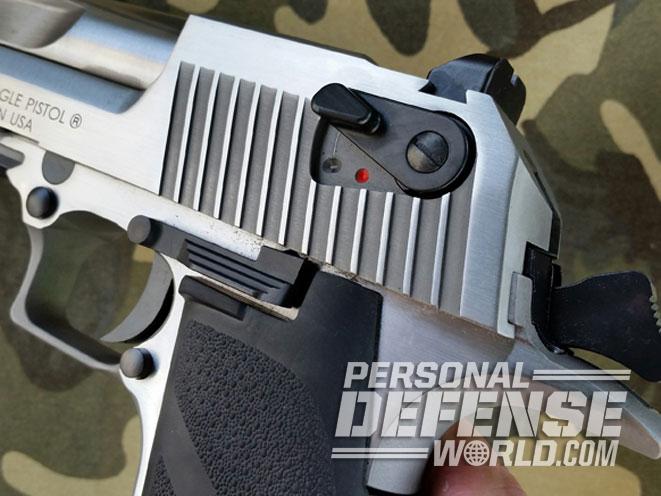
The seven-round, single-stack magazine is made of blue steel with witness holes. The magazine release is located at the rear of the triggerguard, on the left side, a la the 1911. The slide stop is above the trigger on the left side. The Desert Eagle also has a smooth-faced, single-action trigger. The ambidextrous thumb safety is at the rear of the slide. “Fire” is the up position, and down is “safe.” It serves as both a firing pin block and a trigger lock. The gun can be carried “cocked and locked.” The factory-set pull weight on the trigger is about 4 pounds with a little take-up, noticeable creep and a tiny bit of overtravel.
Advertisement — Continue Reading Below
RELATED STORY: Big Bore Test – Magnum Research’s Desert Eagle Mark XIX .50 AE
There are no dots or bars on the sights. They’re just plain black. Both are mounted in dovetails, so they can be pushed laterally for windage or replaced. The slide is deeply serrated on each side.
My test Desert Eagle came from Magnum Research in a large plastic carrying case with compartments on the inside for the pistol and accessories, including one magazine, a safety padlock, the owner’s manual, an instructional DVD and an approved ammunition list. This list is more apropos to the .357 and .44 Magnum versions of this handgun than to the .50 AE. An L-shaped, 5-in-1 disassembly tool is also included. It is useful for removing carbon from the gas cylinder, taking out the firing pin and bolt, disassembling the magazine and removing the grip pin.
Advertisement — Continue Reading Below
Downrange
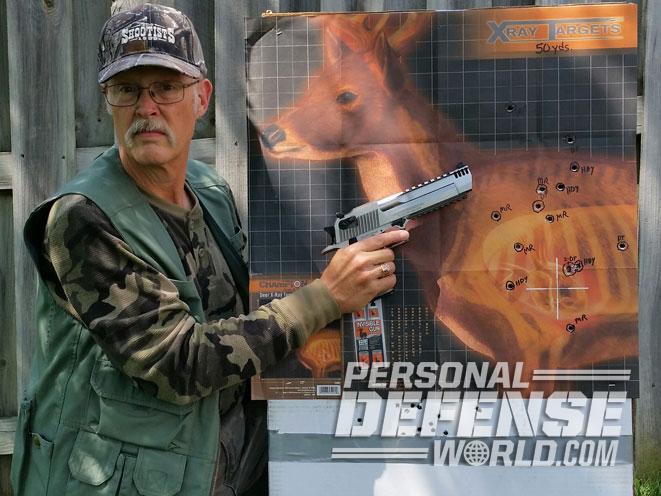
As there are not exactly a plethora of guns chambered for the .50 AE, ammunition is limited to a few sources. I was able obtain to obtain 300-grain ammo from DoubleTap, MRI and Hornady.
RELATED STORY: Desert Eagle Defense – Magnum Research’s 1911U & Baby Desert Eagle IIs
Advertisement — Continue Reading Below
MRI catalogs no less than 24 different holster models for its big pistol. The company has belt holsters, shoulder rigs and even a tactical thigh holster. To me, this is a hunting handgun with perhaps a few other specialized applications. I believe a 4.4-pound pistol is more than I want to carry on my belt, thigh or in a conventional shoulder holster. My concern is not about concealment but good weight distribution, access and comfort. To my mind, this means a tanker/pilot-style holster. There are several sources, but one I saw that I was most impressed with was the Guide’s Choice Chest Holster from Diamond D Custom Leather based out of Alaska. This holster is made from top-grain leather, is easy to adjust to the wearer and whether you are hunting, hiking, camping, whatever, it’s designed for hard work. Each rig is handmade and fitted with a safety strap for gun retention. You can also get a magazine pouch attached to the shoulder strap.
At the range, after measuring the Desert Eagle’s velocities of all three loads, I put up bullseye targets at a distance of 25 yards and fired four 5-shot groups with each of the .50 AE test loads. The 4.4-pound Desert Eagle’s recoil wasn’t so bad, but the muzzle flip, despite the muzzle brake, is impressive. Add to this the fact that the pistol has to be held with “white knuckles” to function properly and what you get is somewhat indifferent accuracy. My best group of the day measured 2.35 inches with Hornady’s 300-grain XTP ammunition. Hornady also gave me the best group average at 2.53 inches and the highest velocity reading. The other .50 AE rounds produced groups between 3 and 4 inches.
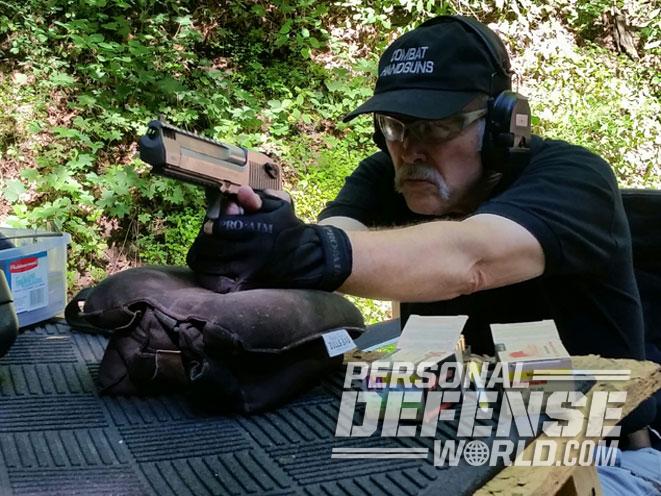
Some further observations are in order. As I said before, the Desert Eagle must be held as firmly as possible for reliable functioning; otherwise you get feeding issues and the slide will fail to go into battery. So, I used shooting gloves to test the pistol. The bore axis on this pistol is rather elevated, which translates into increased muzzle flip. I suggest wearing a baseball cap with a stiff bill when shooting this gun. I found the top of the barrel occasionally “kissed” the front edge of my cap bill, plus the brass sometimes came almost straight back—so make sure you wear those shooting glasses, too. My test gun did not like to feed the first round from the magazine by using the slide release. Although it looks like a pretty straight feed, when I’d depress the catch the first round would plow into the bottom of the feed ramp and the nose of the HP bullet would jam up the works. I found if I used the slide to “slingshot” the first round into the pistol I wouldn’t have a problem.
Advertisement — Continue Reading Below
RELATED STORY: Easy Disassembly of the MRI Desert Eagle Mark XIX
With figures in the vicinity of 1,450 foot-pounds of muzzle energy, the .50 AE Desert Eagle should be just the medicine for wild boar, deer and perhaps somewhat larger game at moderate ranges. Given the accuracy levels I was able to extract from this gun with the open sights, I decided to try the test ammunition on an “X-ray” deer target at 50 yards. Firing five shots with each of the test loads, six rounds hit in the “boiler room” with two DoubleTap bullets clipping the heart and one going through a major blood vessel. One shot went into the lower thorax, five went into the upper thorax and one hit the spine. Two shots went above the target.
Were I going to take this gun into the hunting fields or even consider it for some specialized tactical use, I would mount a reflex sight on the upper rail. I think this would increase the accuracy potential and allow the point of aim/point of impact to mesh so that the guesswork would be taken out of the equation as far as where to place the front sight blade. I would’ve dearly loved to have taken this big pistol out on a hog hunt, and with a proper optical sight in place, I’m sure it would have no trouble bringing home the bacon. The MRI Desert Eagle is not cheap, but it has plenty of power. It will serve well as long as shooting distances are realistic and the user is committed to practice, which is a must for any handgun used while hunting or for tactical purposes.
Advertisement — Continue Reading Below
For more information, visit http://www.magnumresearch.com or call 508-635-4273.
